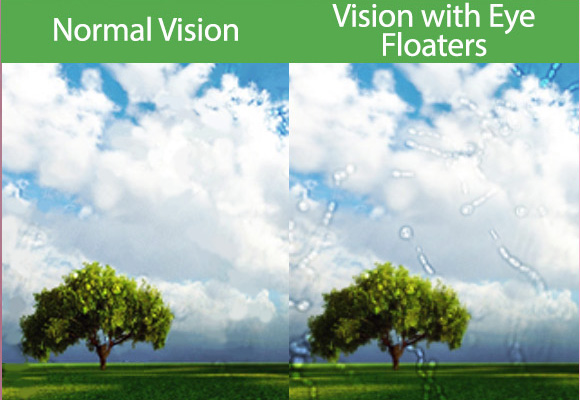Eye Floaters Causes, Symptoms, Diagnosis and Treatment

What are Eye Floaters?
Eye floaters are deposits of various size, shape, consistency, refractive index, and motility within the eye’s vitreous humour, which is normally transparent.
At a young age, the vitreous is transparent, but as one ages, imperfections gradually develop. The common type of floater, which is present in most persons’ eyes, is due to degenerative changes of the vitreous humour.
They can be of different shapes and sizes and may look like:
- tiny black dots
- small, shadowy dots
- larger cloud-like spots
- long, narrow strands
Causes of Eye Floaters:
Eye floaters may be caused by:
- Age-related eye changes.
- Over time, the vitreous partially liquefies a process that causes it to pull away from the eyeball’s interior surface.
- As the vitreous shrinks and sags, it clumps and gets stringy. Bits of this debris block some of the light passing through the eye, casting tiny shadows on the retina.
- Inflammation in the back of the eye.
- Posterior uveitis is inflammation in the layers of the uvea in the back of the eye.
- Bleeding in the eye.
- Torn retina.
- Retinal tears can occur when a sagging vitreous tugs on the retina with enough force to tear it.
- Without treatment, retinal tear may lead to retinal detachment, an accumulation of fluid behind the retina that causes it to separate from the back of your eye.
The following factors increase the likelihood of developing eye floaters:
- Age over 50
- Nearsightedness
- Eye trauma
- Complications from cataract surgery
- Diabetic retinopathy
- Eye inflammation
Symptoms of Eye Floaters:
Symptoms of eye floaters may include:
- Spots in the vision that appear as dark specks or knobby, transparent strings of floating material
- Spots that move when one moves their eyes, so when one try to look at them, they move quickly out of the visual field
- Spots that are most noticeable when one look at a plain bright background, such as a blue sky or a white wall
- Spots that eventually settle down and drift out of the line of vision
Diagnosis of Eye Floaters:
In order to diagnose eye floaters, the doctor would do a complete eye exam, including eye dilation, in order to observe the back of the eyes.
Floaters are often readily observed with the use of an ophthalmoscope or slit lamp.
Treatment of Eye Floaters:
Most eye floaters, although can be frustrating, do not require treatment.
However, if they impair one’s vision treatment may be sought.
Treatment options include:
- Using a laser to disrupt the floaters.
- Using surgery to remove the vitreous.
Related Articles:
5 Foods for the Eyesight and Eye Health
Vitamin C – Using Oranges May Cure Eyesight
Eyestrain Causes, Symptoms, Diagnosis and Treatment
Pink Eye (conjunctivitis) Causes, Symptoms, Diagnosis and Treatment
Rapid Eye Movement Sleep Symptoms, Causes, Diagnosis and Treatment
Eye Melanoma Symptoms, Causes, Diagnosis and Treatment
Eye Bags Symptoms, Causes, Diagnosis and Treatment
Dry Eyes Symptoms, Causes, Diagnosis and Treatment
Trachoma Causes, Symptoms, Diagnosis and Treatment
Natural Remedies for Retinal Vein Occlusion to Help Relieve Itchy Eyes
Fungal Eye Infection Causes, Symptoms, Diagnosis and Treatment
By : Natural Health News




